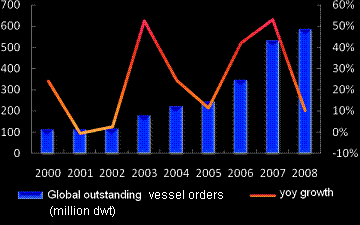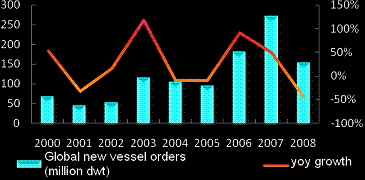
China’s outstanding vessel orders as at Dec 2008 were 211.4 million dwt.
CHINESE SHIPYARDS may be inferior to those in South Korea but the global shipbuilding fallout could throw up a chance for the former to improve competitive advantage, says TX Investment Consulting.
China and South Korea were in a close fight for market share, going by the world’s outstanding vessel order books as at end 2008. They captured market shares of 36.2% and 36.7%, respectively, by deadweight tonnage (dwt).
However, Chinese yards lag behind in technology, yard management and vessel scale.
That will change as the Chinese government makes marine engineering one of its target sectors for economic rejuvenation, said the Chinese stock investment research house in a report issued last week.
China’s 2 largest listed marine vessel builders - Cosco and Yangzijiang – both happen to be listed on SGX.
The duo’s trading volumes surged 5-10 fold last Thursday (12 Feb) following the official statement approving in-principle stimulus measures for the sector.

New vessel orders have trickled to 9 vessels worldwide in Jan 09. Source: Clarksons / TX Investments.
Upgrading China’s marine engineering
Some 80% of vessels delivered out of Chinese yards in 2008 were for foreign flags but global demand has trickled to a mere 9 vessels in Jan 2009.
Even though orders on 5 out of the 9 vessels were given to Chinese yards, the figure is dismal considering that Yangzijiang alone delivered 27 vessels in 2008 of 840,000 dwt each.
While this will keep the yards busy over the coming two years when vessel deliveries will be at historic highs, the spate of recent reports on export contraction bode ill for ship owners.
| Major Export Economies | Year-on-year change in exports |
| Singapore | -34.8% (NODX) |
| South Korea | -32.8% |
| Taiwan | -44.1% |
| China | -17.5% |
| India | -24% |
| Jan 2009 export data source: UOBKH | |
Singapore, for example, saw its non-oil domestic exports nose-dive a record breaking 35% year-on-year in Jan 2009.
The same can be said for other Asian countries.
To mitigate the glut in marine transportation space, China’s State Council will implement the following measures:
(1) Financing
* Banks will extend ship financing to ship owners (including foreigners) whose vessels are being built in approved Chinese yards
* Extend fiscal and financial support for domestic buyers of long-range ships until 2012
(2) Stimulate orders for new vessels
* Encourage decommissioning of older vessels
* Accelerate the phasing out of single-hull tankers
* Restrict construction of new capacity in the industry, such as banning the construction of docks and slipways for 3 years.
(3) Improve the equipment of China’s marine engineering industry
* Support R&D in high-tech vessels and marine engineering equipment
* Support technology upgrade and promote yard innovation
(4) Develop ship repair sector
* Other than increasing the scope of vessels that yards can repair this also includes standardizing and developing ship-laying services
(5) Industry Restructuring
* Promote mergers and acquisitions in the industry
* Promote strategic alliances between large shipbuilders and up/downstream players
* Guide the operational restructuring of smaller vessel builders

China delivered 28.81 million dwt of ships in 2008, the third largest worldwide.
Most ship builders have found it difficult to get newbuilding orders since last August, according to the China Association of the National Shipbuilding Industry (CANSI).
Small and medium yards will be the first victims in the sector fallout.
The younger small and medium sized non-state-owned yards, which depend on bank loans for cash flow will also be hard hit.
New ship orders will drop to between 20 million dwt to 30 million dwt in 2009, compared with 58.18 million dwt last year, said the association.
In the face of these most severe challenges, China, who has the world's largest foreign exchange reserves (US$1.9 trillion as at end 2008) is in a better position than any other nation for a fiscal stimulus.
Read about other simulus measures by China:
China pushes rural spending for 25m job seekers







